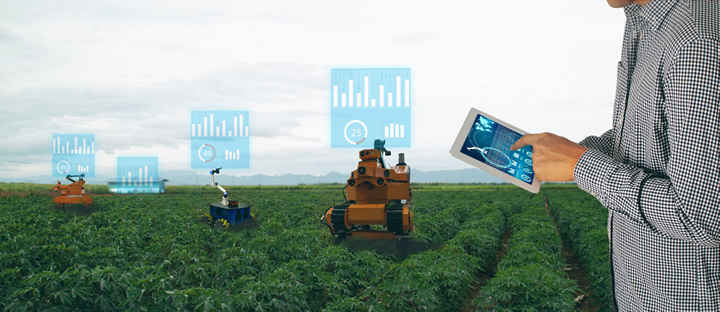Revolutionizing Farming: How Smart Crop Mobility is Shaping the Future of Agriculture

The global Smart Crop Mobility Market is on track for significant growth, projected to exceed USD 13.2 billion by 2032. This growth is fueled by advancements in precision agriculture, autonomous machinery, and the integration of cutting-edge technologies like artificial intelligence (AI), robotics, and the Internet of Things (IoT) in agriculture. As farmers face increasing pressure to maximize yields sustainably while addressing challenges posed by labor shortages and climate variability, smart crop mobility solutions are emerging as transformative tools for the future of farming.
The Role of Smart Crop Mobility in Modern Agriculture
Smart crop mobility encompasses various technologies designed to optimize the movement, monitoring, and management of crops throughout the farming process. This market includes autonomous tractors, drones, GPS-guided machinery, robotic harvesters, and AI-driven crop monitoring systems. By using these technologies, farmers can improve crop management, reduce resource waste, and enhance overall productivity.
The concept goes beyond simple automation; it integrates data analytics and machine learning to predict and respond to crop needs in real-time. For example, autonomous tractors equipped with sensors and GPS navigation systems can perform field tasks with minimal human intervention. Similarly, drones can capture high-resolution images of crops, identifying issues like pest infestations or nutrient deficiencies, allowing for precise interventions.
Key Drivers Behind the Market Growth
- Demand for Sustainable Agriculture: As global populations rise, the need for sustainable food production has intensified. Smart crop mobility technologies enable farmers to optimize resource use, reducing waste of water, fertilizers, and pesticides. Precision in resource allocation not only lowers production costs but also minimizes environmental impact, helping farmers meet sustainability goals while remaining competitive.
- Labor Shortages: The agriculture industry has faced a persistent shortage of skilled labor, especially in regions where younger generations are increasingly seeking urban employment. Autonomous and semi-autonomous farming equipment help bridge this gap, allowing fewer workers to oversee larger areas effectively. With robotic machinery and autonomous vehicles, farm operations can run continuously, reducing dependency on seasonal labor.
- Climate Resilience: Climate change is presenting new challenges to agriculture, such as unpredictable weather patterns, water scarcity, and soil degradation. Smart crop mobility solutions enable farmers to implement precision practices that adapt to changing conditions. Data-driven decision-making tools can help farmers make informed choices on crop planting, irrigation, and harvest timing, ensuring better yields even in adverse conditions.
- Government and Corporate Support: Governments worldwide are recognizing the importance of agri-tech innovations and are offering subsidies and incentives to encourage adoption. In parallel, corporations are investing in research and development to advance smart farming solutions. These combined efforts are accelerating the rollout of smart crop mobility solutions on a global scale.
Technological Innovations Fueling Market Expansion
The smart crop mobility market is rapidly evolving, with AI and machine learning (ML) playing pivotal roles. AI-powered analytics can process data collected from drones, sensors, and satellites to provide real-time insights on crop health and environmental conditions. These insights enable proactive measures, helping farmers prevent yield losses from pest outbreaks or nutrient deficiencies.
Furthermore, autonomous machinery is becoming more sophisticated, with manufacturers developing tractors and harvesters that can operate without human intervention. These machines are equipped with cameras, sensors, and LiDAR technology to navigate fields, avoid obstacles, and ensure accurate planting or harvesting. With ongoing advancements, autonomous machinery is expected to handle complex tasks, from soil preparation to crop picking, with precision.
Drones also represent a transformative tool in smart crop mobility, allowing farmers to conduct aerial surveys and monitor crop health over large areas. Equipped with thermal and multispectral imaging, drones can detect variations in crop growth, identifying stress areas that require immediate attention. This early intervention capacity enables farmers to reduce losses, optimize input use, and increase yield.
Future Prospects and Challenges
Despite its promising growth trajectory, the smart crop mobility market faces several challenges. High initial costs for smart equipment and technology can be a barrier for small-scale farmers, particularly in developing regions. However, with technological advancements and increased government support, costs are gradually becoming more manageable.
Another challenge is data management and integration. To function effectively, smart crop mobility solutions rely on large volumes of data from multiple sources. Ensuring compatibility and effective data analysis across platforms is essential for providing farmers with actionable insights. As cloud computing and IoT ecosystems become more accessible, data integration issues are expected to diminish.
Conclusion
The smart crop mobility market is on the cusp of a breakthrough, set to surpass USD 13.2 billion by 2032. As technology reshapes traditional farming, smart crop mobility solutions offer unprecedented opportunities to enhance productivity, sustainability, and resilience in agriculture. By adopting AI-driven machinery, drones, and autonomous tractors, farmers can improve yields, reduce costs, and address the pressing challenges of modern agriculture.
With continued advancements and supportive policies, smart crop mobility stands to redefine agriculture, making it more efficient, sustainable, and adaptable to future challenges. As the world embraces this technological shift, smart crop mobility will undoubtedly become a cornerstone of a sustainable and resilient global food system.
Source: https://www.gminsights.com/industry-analysis/smart-crop-mobility-market
Comments (0)
This post does not have any comments. Be the first to leave a comment below.
Featured Product

